I noticed that the fact that NISER currently has 43 regular faculty and 18 visiting faculty is not by accident or not because the institute is new and it needs visiting faculty to help in teaching, but is because NISER is designed to have additional 40% faculty as visiting faculty.
This comes out clearly in the design specs for the academic campus. For example, in https://www.orissalinks.com/archives/1820 it is clearly stated that there will be offices for 250 faculty and additional 100 visiting faculty. This is in addition to having space for 150 post-doctoral fellows. (IISERs talk about 200 faculty and do not mention visiting faculty.)
This feature of having about additional 40% visiting faculty is more of a feature of DAE institutes like TIFR and is in contrast to most MHRD institutions. For example, the IISERs do not have that many visiting faculty.
Having such a high percentage of visiting faculty will enrich NISER’s environment and will be one of its signature distinguishing features. It will also help in faculty recruitment in that it can take in some highly regarded prospective faculty immediately as visiting faculty while they go through the formal approval process of a regular faculty position.
NISER has not yet advertised or highlighted about this feature of having such a high percent of visiting faculty positions. It should. Also, it should spread the word about its visiting positions widely to attract visitors from all over the world.
Another design feature of NISER vis-a-vis IISERs is its lower faculty student ratio. Its target is to have 250 regular faculty plus 100 visiting faculty and 1750 students (including 150 post-docs); making it a target ratio of 1:7 (if one just counts the regular faculty). In comparison IISERs are designed to have 200 faculty and 2055 students (including post-docs); making it a target ratio of 1:10.
While NISER’s target faculty-student ratio is 1:7, its current regular-faculty-student ratio is about 1:4.6. That means NISER is ahead in its faculty recruiting. For this all kudos go to the NISER director Prof. T. K. Chandrashekar.
August 16th, 2010
Following is an item from the Biology Journal Club of NISER.
| Title : |
Chilika lake |
| Speaker : |
Dr. Ajit Pattanaik |
| Date/Time : |
2010-08-13 14:00 Hrs |
| Abstract : |
Faculties from School of Biology, NISER are interested to carry out certain research projects which can fit well with the Chilika-development projects. These include identifying new organisms, novel compounds and toxins from plants as well as from animals from Chilika lake and more. Dr. Ajit Pattanaik, Director, Chilika Development Authority has accepted our invitation and agreed to com to NISER with his team of experts and scientists. He will deliver a talk and after his presentation, scientists from NISER will discuss with Dr. Pattanaik and his team. All possible avenues of collaboration between NISER and CDA will be discussed which will have mutual interest and benefit to all. |
August 11th, 2010
Following is an excerpt from a report in Telegraph.
The National Institute of Science Education and Research (NISER), Bhubaneswar, has signed a memorandum of understanding (MoU) with two city-based institutes for analysing the origin and progression of stress and metabolic syndrome (SMS) and its links with diabetes.
The NISER signed an MoU with the Kanungo Institute of Diabetes Specialities (KIDS) to carry out a collaborative project on clinical, behavioural and epidemiological data on SMS and diabetes yesterday.
It also roped in the Institute of Life Sciences (ILS) to use the KIDS’ expertise in genomic studies, laboratory facilities and library for research.
… Chairman and managing director of KIDS Dr Alok Kanungo said: “While India has the highest prevalent diabetes – about 20 per cent of the total diabetic population in the world, there are 40 lakh diabetics in the state. As per statistics released by the state health department, the number of patients has been increased upto 5 lakh in the past five years.”
… “Currently more than 20 per cent of the adult population are suffering from stress related diseases due to change in lifestyle. This also leads to the pre-diabetes stage. However, we are yet to get the Indian database either on SMS or pre-diabetes. This collaboration is expected to let us know the role of Indian genetics in diabetes,” he added.
“The KIDS has a state-of-the-art super speciality diabetes centre with latest infrastructure,” he said.
“Our focus area of research will be SMS leading to diabetes and other physiological abnormalities at molecular level. The clinical, behavioural, epidemiological and susceptibility aspects of the patients of the KIDS will be studied to understand the link in Indian genetic perspective. The research is based on the private public entrepreneurship model of the NISER,” said Palok Aich, the chairperson of School of Biological Sciences, NISER.
“The ILS, being a leading centre of studies in genetics, will help our students and researchers regarding infrastructure and library use,” he said.
This is really great. Once the AIIMS-like institution gets operational it will further increase such collaboration the Biology, Life science and Human Health areas.These kind of collaborations is one of the motivation behind having clusters of institutions nearby. Their impact gets multiplied and the overall impact becomes many times the sum of their individual impact. However, Odisha needs multiple such clusters. Hence my suggestions on several tiers of clusters. See http://www.orissa2020.org/home/area-wise-plan.
Some past relevant articles:
August 9th, 2010
Earlier we reported on the shortage of Math Ph.D’s in India. Slowly the Bhubaneswar area is emerging as a center for Mathematics starting from mentoring at the high school level (at IMA) to pursuing Ph.D at NISER, IIT, Utkal and Ravenshaw. There is also a good chance that one of the proposed 10 science magnet high schools will be established in this area. (The top Math center in India is Chennai which has IIT Madras, Institute of Mathematical Sciences and Chennai Mathematical Institute.) Below we list Math faculty (mostly with Ph.Ds) in institutes and universities in the Bhubaneswar area.
| NISER Bhubaneswar |
|
IIT Bhubaneswar |
IMA Bhubaneswar |
Varadharajan Muruganandam, Associate Professor, Ph.D IIT Kanpur
|
1 |
Sabyasachi Pani, Assistant Professor, Ph.D IIT Kharagpur |
Swadhinananda Pattanayak, Ph.D, Director and Professor |
Binod Kumar Sahoo, Assistant Professor, Ph.D ISI
|
2 |
Akshay Kumar Ojha, Assistant Professor, Ph.D Utkal
|
Mahendra Nath Mishra, Ph.D, Professor in Statistics |
Brundaban Sahu, Assistant Professor, Ph.D Harish-Chandra Research Institute
|
3 |
Abhijit Datta Banik, Assistant Professor, Ph.D IIT Kharagpur
|
Shishir Kumar Sahoo, Ph.D, Registrar and Reader |
Deepak K. Dalai, Assistant Professor, Ph.D ISI
|
4 |
Tarakanth Nayak, Assistant Professor, Ph.D IIT Guwahati
|
Seshadev Pradhan, Lecturer, Ph.D IIT Kharagpur |
Kamal Lochan Patra, Assistant Professor, Ph.D IIT Kanpur
|
5 |
|
Sasmita Barik, Lecturer, Ph.D IIT Guwahati |
Sanjay Parui, Asssitant Professor, Ph.D ISI
|
6 |
|
Jugal Mohapatra, Lecturer, Ph.D IIT Guwahati |
Narahari Parhi, Ph.D, Visiting Professor
|
7 |
|
G. Das, Ph.D, Guest Faculty, formerly from Utkal University |
P. C. Das, Ph.D, Visiting Professor, Formerly at IIT Kanpur
|
8 |
|
J. Sarangi, Ph.D, Guest Faculty |
| |
9 |
|
A. N. Mohapatra ??, Ph.D Sambalpur |
| |
10 |
|
Sraban Mohanty ??, Ph.D IIT Guwahati |
| Utkal University, Mathematics Dept. |
|
Utkal University, Statistics Dept. |
Ravenshaw University, Mathematics and Statistics Departments |
| Salila Dutta, Ph.D, Reader & HOD |
1 |
G. Mishra, Ph.D, Professor & HOD |
Swapan kumar Ghosh, Ph.D. Reader |
| S. Padhy, Ph.D, Professor |
2 |
L. N. Sahoo, Ph.D, Professor |
Nityananda Senapati, Ph.D. Reader |
| B. K. Nayak, Ph.D, Professor |
3 |
P. K. Tripathy, Ph.D, Reader |
Rajani Ballav Dash, Ph.D. Reader |
| J. Patel, Ph.D, Professor |
4 |
K. B. Panda, Ph.D, Reader |
Hadibandhu Pattanayak, Ph.D. Reader |
| Mrs. N. Das, Ph.D, Reader |
5 |
R. K. Sahoo, Ph.D, Lecturer |
Mrs. Minakshi Dash, M.Sc. Reader |
| |
6 |
|
Mrs. Minati Samal, M.Sc. Reader |
| |
7 |
|
Sarat Ch. Senapati, M.Phil. Sr. Lecturer, Statistics |
| |
8 |
|
Mrs. Swarnalata Mishra, M.Phil, Sr. Lecturer, Statistics |
| Others |
|
Others |
Others |
| Rupaj K Nayak, Ph.D Utkal, Senior Lecturer at IIIT, Bhubaneswar |
1 |
S. P. Mohanty, Ph.D. Utkal, HOD at CET Bhubaneswar. |
|
Related pointers from the past:
August 4th, 2010
Following is from a report in Times of India.
The National Institute of Science Education and Research (NISER) will soon start a research programme on subjects significant for the state’s development such as mineral resources and marine biology.
… Kakodkar said, "NISER is going to be the dream institution of our vision. Research and innovation must go hand in hand. Research on one side would facilitate growth of knowledge and bring about innovation while on the other hand the innovations would make the societies prosper and evolve. NISER has started establishing linkages with institutes in the neighbourhood."
NISER is planning to start integrated PhD programme where students will be selected after their BSc degree. The institute has signed an MoU with the Institute of Life Science (ILS), Bhubaneswar, to establish collaboration of research and educational programmes, exchange and complement facilities available in both institutions. The collaboration would also allow PhD students of ILS to take pre-PhD course work at NISER and take up joint research on subjects of mutual interest.
Similarly, NISER has also decided to tie up with the city-based Kanungo Institute of Diabetes Specialties (KIDS) to do research in areas such as correlating stress and diabetes, correlating stress, behaviour and other metabolic syndromes. The KIDS clinicians and researchers would collaborate with NISER researchers in areas of mutual interest by using each other’s facilities.
Director of NISER T K Chandrasekhar said the institute was getting a large number of applications for pure science courses. "This year, about 15,000 students applied for the integrated MSc course. As many as 9000 appeared in the National Eligibility Selection Test (NEST) for the 60 seats in the course," he added.
Out of the 60 undergraduate students that have been admitted to this fourth batch 9 have Odia sounding names which makes it about 15%. Similarly out of 23 Ph.D students that have been selected this year 9 have Odia sounding names.
NISER Bhubaneswar, which started classes in 2007, and hired its first regular faculty (other than the Director who joined in late 2008) in mid 2009 now has 61 faculty out of which 42 are regular faculty and 19 are visiting faculty. The school wise break-up is as follows: Biological Sciences (12 regular + 3 visiting), Chemical Sciences (12+5), Mathematical Sciences (5+2), Physical Sciences(13+5), Others (0+4). All the faculty have very strong research records.
In comparison the faculty numbers in the IISERs (as of today and not counting faculty who will join after July 2010) are: Kolkata – started classes in 2006 (62 regular), Pune – started classes in 2006 (47 regular+4 visiting), Mohali – started classes in 2007 (33 regular +1 visiting), Bhopal – started classes in 2008 (30 regular + 2 visiting) , and Thiruvananthapuram – started classes in 2008 (20 regular + 2 visiting).
Related Links:
July 29th, 2010
Update:The expanded ads are now in the NISER web site. See the links below.
One thing to note is that NISER is likely to implement the PRIS (Performance related incentive scheme) of DAE under which there is provision for monthly incentive of 20% of basic salary. This is already implemented in some DAE institutions. See for example http://www.saha.ac.in/cs/adm.cs/ADM/PRIS.pdf.
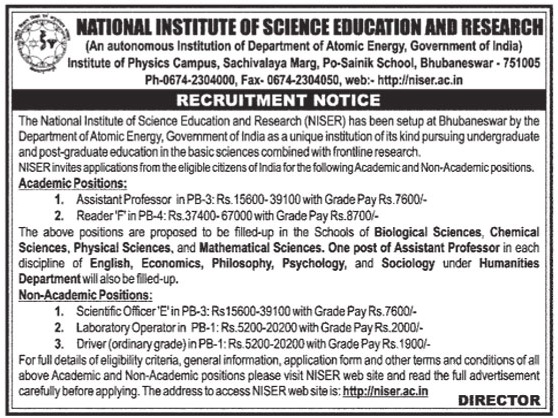
The expanded version of this ad is not yet in NISER website. The ad from last year is at http://niser.ac.in/notices/2009/new-faculty.php and gives an idea of how much the initial salaries will be. following is an excerpt.
ASST. PROFESSOR : Pay Band Rs 15,600 – 39,100 + Grade Pay 7,600
Basic pay on initial appointment will be Rs 29,920 + 22% D.A at current rates + 20% HRA on basic pay. Total emoluments will be approximately Rs 44,438/- per month.
READER (F) – Pay Band Rs 37,400 – 67,000 + Grade Pay 8,700
Basic pay on initial appointment will be Rs 46,100 + 22% DA at current rates + 20% HRA on basic pay. Total emoluments will be approximately Rs 67,414/- per month.
Currently NISER has the following numbers of faculty in the various disciplines:
This adds up to a total of 37 permanent and 21 visiting faculty.
As a comparison IIT Bhubaneswar currently has 37 permanent faculty and 4 visiting faculty with the following break-up.
June 1st, 2010
(Thanks to the Suryanarayanan’s comment number 147 in https://www.orissalinks.com/archives/285).
The IISER admission site at http://www.iiser-admissions.in/ says that there will be three ways to get admission in the IISERs: (i) KVPY (ii) IIT JEE and (iii) Direct.
But by "Direct" they mean through an aptitude test that will be held on July 18 2010. They say:
Direct Admission is open to applicants who have Physics, Chemistry, Mathematics and/or Biology in their class 12 board examination. Aptitude Assessment consists of a written test. It will have multiple choice questions on Physics Chemistry, Mathematics and Biology based on CBSE syllabus up to class 12.
The NISER NEST exam will be on June 6th. Details at http://www.nestexam.in/index1.php.
IISERs and NISER should have co-ordinated to have a single test. It does not make sense to have separate tests for admission into similar programs. Such lack of co-ordination and foresight is what encourages the government to interfere and issue diktats.
March 15th, 2010
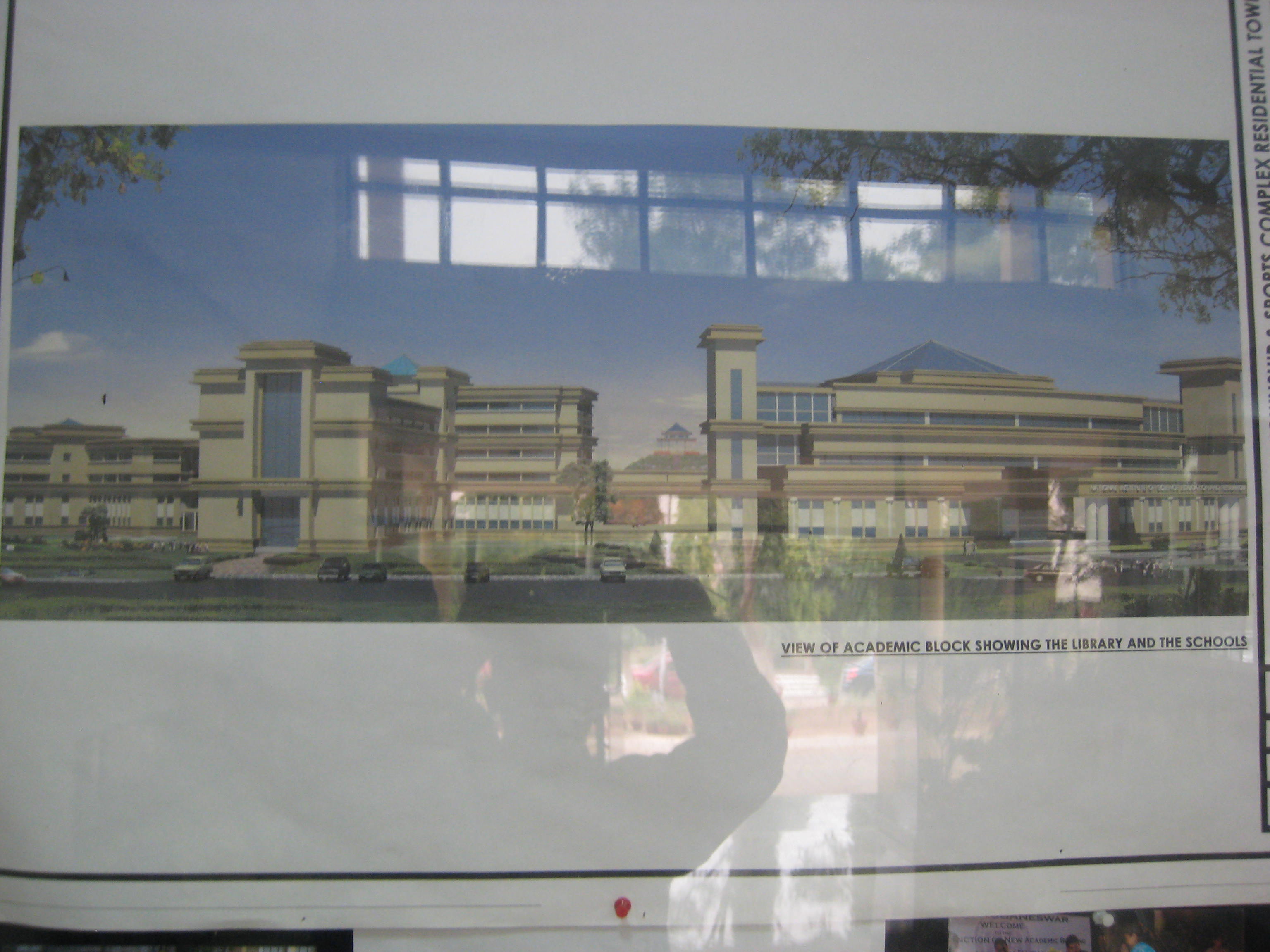
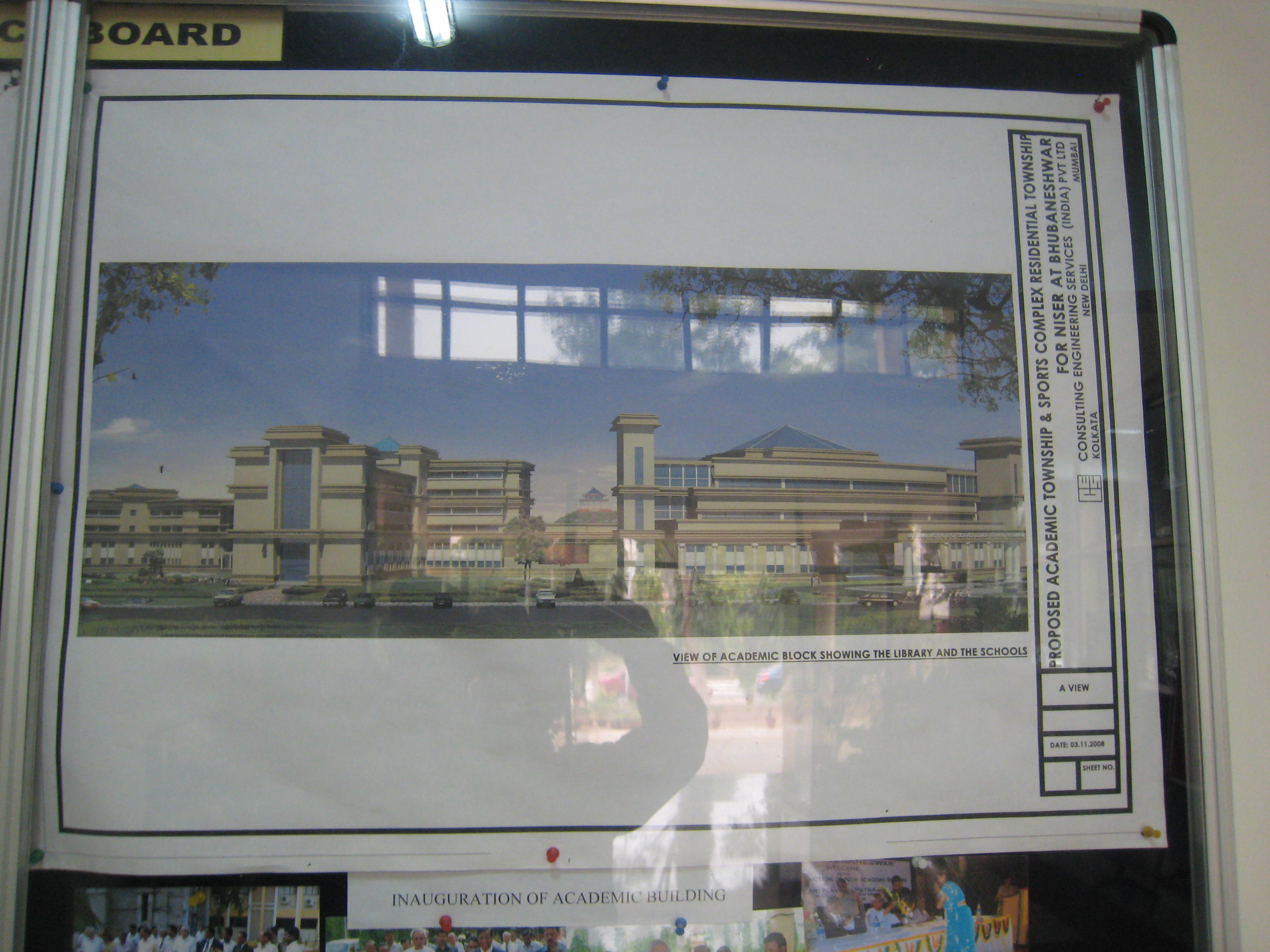
March 1st, 2010
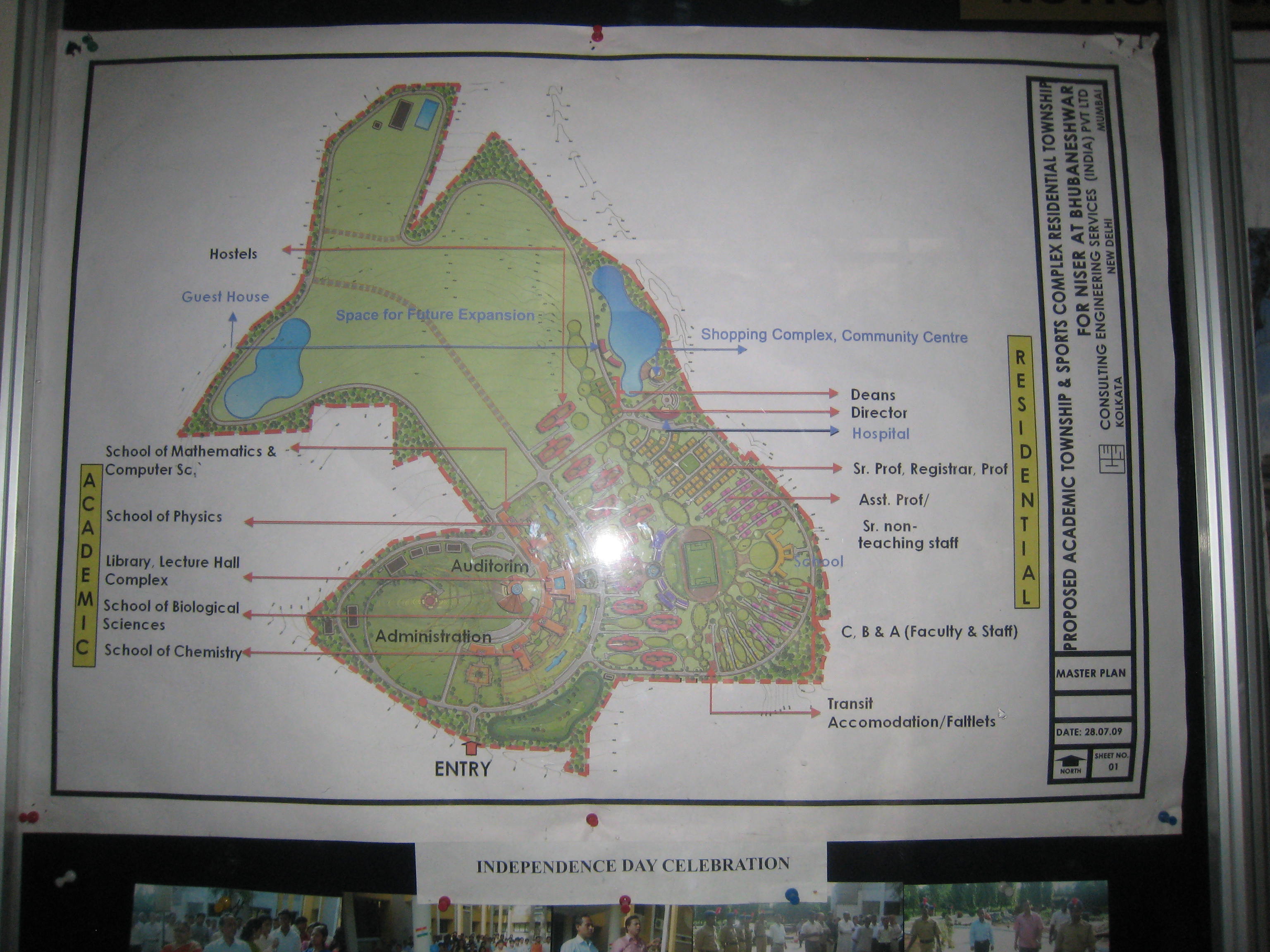
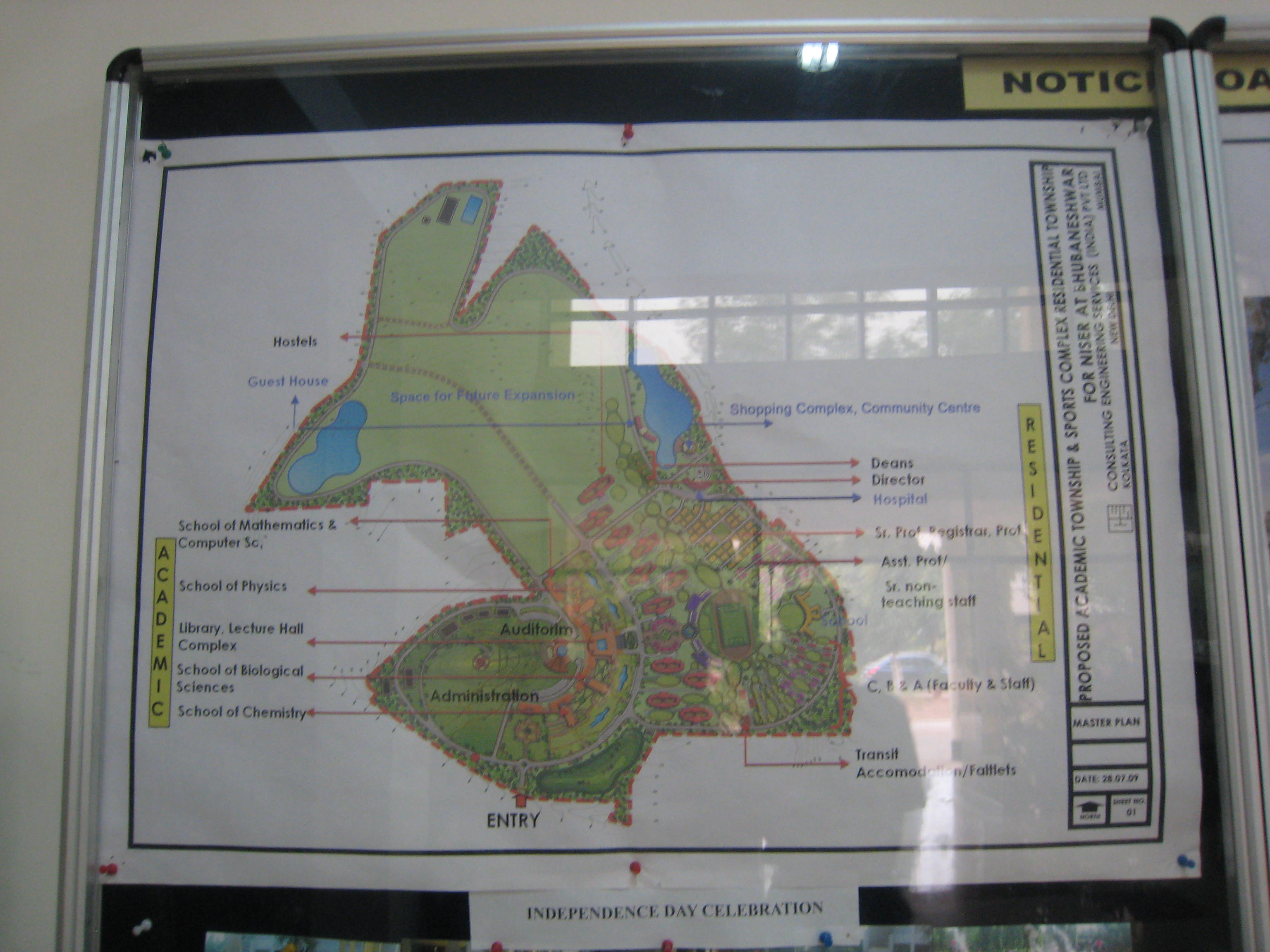
March 1st, 2010
I was discussing with several people associated with NISER Bhubaneswar. I was told that the NISERs and IISER are having difficulty finding good faculty in mathematics, especially in pure mathematics. (On the other hand they can find very good people in Physics, Chemistry and Biology.) I did a quick survey of the IISERs and NISER and indeed they have much more faculty in Physics, Chemistry and Biology than in Mathematics. Following is a rough count made on Jan 30, 2010.
| |
Physics
|
Chemistry |
Mathematics |
Biology |
Others |
Total |
| IISER Kolkata |
20 |
19 |
3 |
7 |
7 |
56 |
|
IISER Pune
(some have joint appointments)
|
11.5
(includes 3 joint)
|
14 |
7
(includes 2 joint)
|
13.5
(includes 3 joint)
|
0 |
46 |
|
NISER, Bhubaneswar
(permanent + visiting)
|
12 (7 + 5) |
15 (10 +5) |
9 (5 +4) |
15 (7+8) |
4 (0+4) |
55 |
|
IISER, Mohali
(permanent + visiting)
|
8 + 2 |
9.5 |
4 + 1 |
8.5 |
0+1 |
34 |
|
IISER, Bhopal
(Current + to join in June 2010)
|
6 + 1 (includes 1 visiting) |
13+1 |
4 (includes 1 visiting) |
5+2 |
2 (includes 1 visiting) |
34 |
|
IISER, Thiruvantapuram
(Current + to join in June 2010)
|
4+5 |
5 |
2 |
2+1 |
|
19 |
As evident from the above, all of the above institutes are struggling in hiring faculty in Mathematics. Also, while the young faculty in the other fields (Physics, Chemistry and Biology) mostly have post-doc experiences, most of the younger Math faculty do not have that experience.
One of the reasons behind the shortage of Math Ph.ds is that most people who love Mathematics in high school go on to pursue engineering and perhaps there is a mistaken impression that the career prospects in mathematics is not good. Thus there is a big need for institutions like
The Institute of Mathematics and applications, Bhubaneswar
which is making great efforts to popularize Math among youngsters.
I hope some of the people who loved Math in high school, and now are in other (say IT) jobs would consider pursuing Math. Some of the top places to pursue Ph.D in Mathematics in India are:
India could also consider hiring foreigners. At least in the USA many Math Ph.Ds from top schools do not get a tenure track faculty position and end up teaching in community colleges. Some of them may jump at an opportunity to be a faculty in IISERs, NISER and other institutions.
January 30th, 2010
.jpg)
.jpg)
Ravenshaw University should start 5 yr integrated programs in Science subjects and take its students through this exam.
January 7th, 2010
Update: Additional coverage at http://niser.ac.in/docs/2009/pmvisit-27-12-09.php.
Following is from http://pib.nic.in/release/release.asp?relid=56479.
I am delighted to be here today to participate in the foundation stone laying ceremony of this National Institute of Science Education and Research. The institute symbolizes our commitment to the development of Odisha and its people. It also symbolizes our commitment to the cause of education, and particularly to science education.
We recognise the important role that education has to play in our development process and our steady progress towards being a modern knowledge society. In the last about five years our government has undertaken a massive expansion and improvement of our education system at all levels. But we realize that we need to do much more.
In the area of science education particularly, I share the concern that our best minds are not turning to science. We must find ways of making science more attractive to our youth. We must improve the quality of teaching in science and mathematics at the school level. At the university level we must ensure better infrastructure, high quality faculty and greater interaction between academia and industry.
Since independence, there has been a great deal of progress in our Science & Technology system. This is evident from the success of the mission-oriented Science &Technology agencies, like the family of Department of Atomic Energy institutions, that have made our nation proud. We are committed to ensure operational autonomy, including in matters of appointments, to various institutions of excellence under the Department of Atomic Energy as is the case with some other scientific institutions of eminence in India.
I am also aware that we need to increase our expenditure on Science & Technology from its current level of 1% of our GDP. This is about half of the level of developed countries. The Government is committed to increasing Research & Development funding and for the last few years, we have been allocating larger budgets in this area. But I also expect the private sector to do more for Research & Development. We also need more public- private partnership in Research & Development in all areas of Science & Technology.
One way of making careers in science and technology attractive would be to improve remuneration and ensure the integrity of the selection process. It is well known that the initial starting salary for scientists with a PhD in India is often lower than those of Engineers, Doctors and Management graduates. It is obvious that if talented young people are to be retained in science, scientists have to be treated differently than other Government employees in service and salary matters.
It is our expectation that the National Institute of Science Education and Research will produce scientific trained manpower of a very high quality which could directly find placement across the country. There will be greater emphasis on branches of science relevant to the Department of Atomic Energy, which also cater to better exploitation and utilization of Odisha’s natural resources. Odisha’s mineral and marine resources will be taken into consideration in designing training programs for students here.
We expect NISER to be an institute at par with the best in the country in terms of facilities and faculty. It will have a research to teaching load as practiced in the best universities in the world. This will ensure world class education and also attract the best researchers. It will have world-class experimental facilities in all the current and emerging branches of science including physics, chemistry, modern biology and environmental sciences. I am confident that the National Institute of Science Education and Research will become an eminent institute for science like TIFR and IISc.
Let me end by wishing the National Institute of Science Education and Research all the very best in the years to come. Odisha has produced many outstanding scientists like Jogesh Chandra Pati. I hope this institution will produce many more great men of science. I also wish all of you all success in your efforts to make India stronger in Science and Technology.”
*****
AD
December 27th, 2009
The page http://www.dcsem.gov.in/Page/Tender.htm has the following.
|
Sl.No.
|
Name of Work
|
Estimated
Cost
(Rs. In Lakhs)
|
NIT No.
|
Sale Period
|
For Details
|
|
1

|
Construction of Academic Township , Sports Complex and Residential Township alongwith necessary Infra structure Facilities For National Institute of Science Education and Research (NISER) at Jatni, Khurda ORISSA.
|
450
Crore
|
DCSEM / CE (PCD) /NISER/A & R / PQ/07 / 2009 dt 30.11.2009.
|
07-12-2009
To
24.12.2009
|
Click Here
|
Following is from the page reached by clicking the above link.
Government of India
Department of Atomic Energy
Directorate of Construction, Services & Estate Management
INVITATION FOR PREQUALIFICATION OF CONTRACTING AGENCIES
PQ No : DCSEM / CE (PCD) /NISER/A & R / PQ/07 / 2009 dt 30.11.2009
Director, Directorate of Construction Services & Estate Management (DCSEM), DAE, on behalf of the President of India, invites Pre-qualification applications from reputed, qualified, experienced and financially sound Engineering construction agencies for “Construction of Academic Township , Sports Complex and Residential Township alongwith necessary Infra structure Facilities For National Institute of Science Education and Research (NISER) at Jatni, Khurda ORISSA The proposed scope of work shall include Civil Construction works, Internal & External P.H., Fire Fighting, Internal Roads, Storm Water Drains, Rain Water Harvesting , Internal & External Electrical Works ,HVAC, and Development works etc. The works are listed below.
|
S.N
|
Description of Works
|
Approximate Area
|
|
1
|
ACADEMIC TOWNSHIP Consisting of School of Sciences including Class Rooms, Administration, Library, Workshop, Auditorium Complex including Cafeteria, Lecture Hall Complex, Student Activity Centre, Other Facilities like Animal House, Green House and Bio Safety P3 Laboratory and Meditation Centre etc
|
64,923/- Sq.m
|
|
2
|
SPORTS COMPLEX & AQUATIC FACILITIES
|
2,000/- Sq.m
|
|
3
|
RESIDENTIAL TOWNSHIP Consisting of
Hostel complex of Double Occupancy Rooms for 800 Students and Single Occupancy Rooms for 1000 Students, Efficiency Apartments Type I & II , Residential Accommodation for Faculty/Staff of Type A to E, E1 & E3, Other Facilities such as Day care Centre, Primary & Higher Secondary School, Hospital 20 Bed, Shopping and Community Centre and Guest House etc
|
1,06,913/- Sq.m
|
The estimated cost for the work is projected to be Rs. 450 crore (approx). Time of completion is 36 months.
The interested agencies are required to furnish the following documents for consideration of issue of “Pre -Qualification Document” . Joint ventures are not accepted
a) Proof of registration with Government / Semi Government organisations like Railways, PWD, CPWD, MES etc. in appropriate class or having experience in carrying out similar type of works.
b) Annual turnover as per ITCC or Profit & Loss statement for the last 3 years
c) ‘PAN’ reference,
d) TIN reference,
e) Latest Bank Solvency Certificate
f) WCT registration certificate,
g) Performance Certificates;
h) List of similar works in hand and Works carried out by them for the last seven years indicating the Agency for whom executed, Value of work, Completion time : Stipulated & Actual or present position of the work.
i) List of Technical staff they possess.
j) List of construction plants, machinery & infrastructure facilities they possess.
Agencies fulfilling following criteria shall be eligible to participate:
(a) Experience of having successfully completed any of the following works during
last seven years ending 30-11-2009 :
(i) 3 similar works completed costing not less than Rs.180 crore each; or
2 similar works completed costing not less than Rs.270 crore each; or
1 similar work completed costing not less than Rs.360 crore
and
(ii) One completed work of any nature ( either part of (i) above or a separate one) costing not less than Rs. 180 crore with some Central/State Government/ Central Autonomous Body/ Central Public Sector Undertaking
(b) Bank Solvency Certificate of Minimum Value Rs.180 crore.
(c) Average Annual turnover during last 3 years ending 31.03.2009 should be
at least Rs.135 crore
Similar works means Development and Construction of Residential/Commercial / Institute / Office Buildings with RCC framed structure, including PH , Electrical, HVAC and development works
The value of works shall be brought to current costing level by enhancing the actual value of work at simple rate of 7% per annum : calculated from the date of completion to last date of receipt of applications for Pre-Qualification documents.
[d) Not having incurred any loss in more than 2 years during last 5 years ending
31-3-2009.
Pre qualification documents shall be issued from 07-12-2009 to 24.12.2009 between 11 00 hrs. & 16 00 hrs on all working days from the Office of Chief Engineer(PCD),DCSEM, DAE, 3rd Floor, V.S.Bhavan, Anushaktinagar, Mumbai – 94.Cost of the document (non refundable) shall be Rs.1500/- in cash if collected in person and Rs.2000/- if required by Post, by crossed Demand Draft drawn in favour of Accounts Officer, DCSEM, payable at Mumbai. Pre qualification documents if required by post shall be sent by Indian Speed Post only, at the agency’s risk. The documents shall be received in person only, up to 15 00 hrs on 05-01-2010 in the Office of the Chief Engineer (PCD) and shall be opened at 15 30 hrs on the same day. If any information furnished by the applicant is found incorrect at a later stage, they shall be liable to be debarred from tendering/taking up of work in DCSEM. The Department reserves the right to verify the particulars furnished by the applicant independently and reject any application without assigning any reason and to restrict the list of pre-qualified contractors to any number deemed suitable in case too many applications are received satisfying the basic Pre-Qualification criteria . Short listing of the agencies shall be subject to thorough verification of their credentials and inspection of works carried out by them, through a Technical Evaluation Committee of experts, constituted by DCSEM.
For further details please contact 022-25487320 & 25487324. Fax 022-25565362
Please click here to Download Pre Qualification Document
Our previous entry on NISER tender was at
https://www.orissalinks.com/archives/1816. Earlier the budget for the construction was 290 crores. In this tender the amount seems to have been raised to 450 crores.
December 8th, 2009
Following is from Samaja.
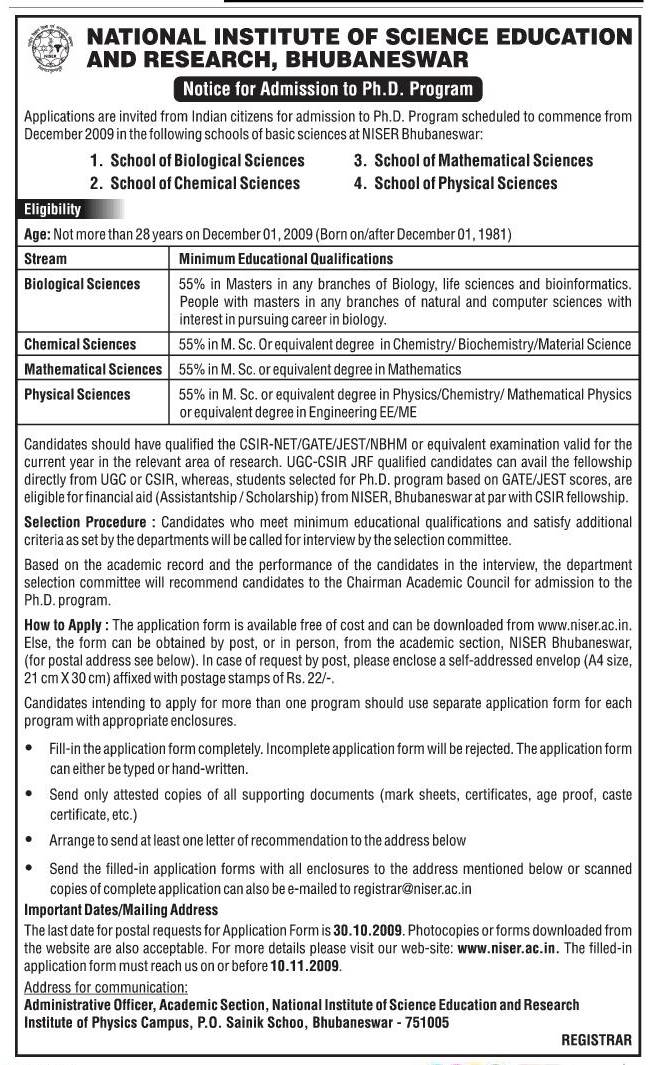
October 8th, 2009
Update on 27th April 2011: The Central University location has been changed to Bander Sindri near Ajmer and only 80 kms from Jaipur. The Innovation University (previsouly referred to as National University) aiming for world class is now pushed for Jaipur. [Times of India]
The panel set up by the CM of Rajsthan has picked the following places to recommend to the central government for the various national institutes and universities coming up in Rajasthan. (From a Times of India report and another Times of India report)
- IIT : Jodhpur
- IIM: Udaipur
- National University aiming for world-class: Ajmer
- Central university: Bikaner.
The committee also recommended:
- a "futuristic" heritage conservation and museology centre in Jaipur
- an institute of Food Technology in Hadoti region of Kota
Currently the following national institutions exisit or are being made in the following places in Rajasthan:
- NIT: Jaipur
- LNMIT (private but top-notch): Jaipur
- National law School: Jodhpur
- AIIMS-like institution (being made): Jodhpur
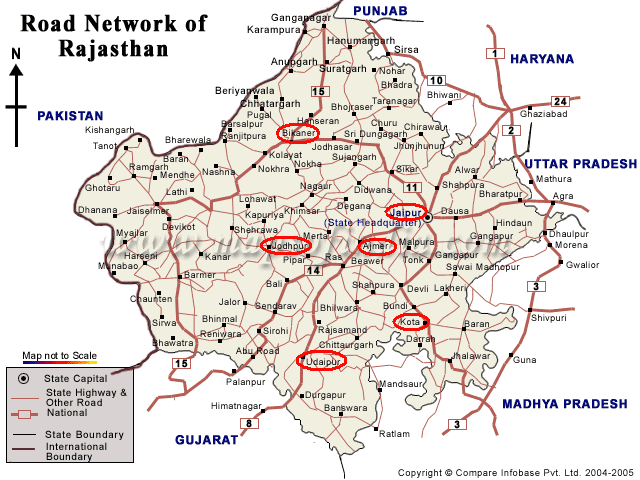
The institutions are nicely distributed between various cities of Rajsthan, although people of Jaipur and Kota are not happy. The population of these locations are:
- Jaipur (World Gazetteer 2009): 3.1 million (has inetrnational air connectivity)
- Jodhpur (World Gazetteer 2009): 988K – (332 kms from Jaipur; has air connectivity)
- Udaipur (World Gazetteer 2009): 457K – (400 kms from Jaipur; has air connectivity)
- Ajmer (World Gazetteer 2009): 604.7K – (131 kms from Jaipur)
- Bikaner (World Gazetteer 2009): 624.6K – (321 kms from Jaipur)
- Kota (World Gazetteer 2009): 823 K (242 kms from Jaipur)
In contrast in Orissa the distribution of national institutions are more Bhubaneswar centric. Following is the status:
- IIT: Bhubaneswar
- NISER: Bhubaneswar
- AIIMS-like (being made) : Bhubaneswar
- National Law University: Cuttack (part of Bhubaneswar metroplex)
- IIIT (state-funded) : Bhubaneswar
- National University aiming to be world class: Bhubaneswar
- Vedanta University (private): Puri
- NIT: Rourkela
- Central University: Koraput
- IIIT (centrally funded): state wants it in Berhampur; center has identified as Bhubaneswar
Unfortunately, one of the reason given behind the above selection is the lack of connectivity and the size of places. Following is some information on that.
- Bhubaneswar (World Gazetteer 2009): 1.67 million (has airport but no inetrnational connectivity)
- Rourkela (World Gazetteer 2009): 551 K (no air connections) – 334 kms from Bhubaneswar
- Berhampur (World Gazetteer 2009): 403 K (no air connections) – 160 kms from Bhubaneswar
- Koraput-Jeypore-Sunabeda: 200K+ (no air connections) – 499 kms from bhubaneswar
- Puri (World Gazetteer 2009): 185K – 60 kms from Bhubaneswar
- Sambalpur (World Gazetteer 2009): 258 K (no air connections) – 321 kms from Bhubaneswar
- Jharsuguda-Belpahar-Brajarajnagar: 200 K (no air connections) – 374 kms from Bhubaneswar; 50 kms from Sambalpur
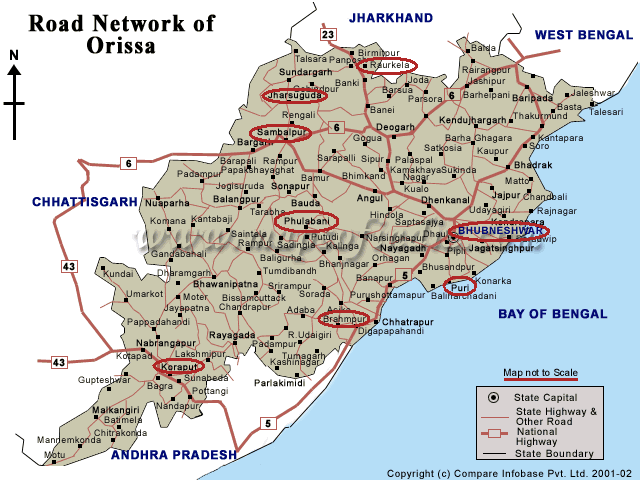
For the future, following are some of the steps that Orissa government needs to urgently take regarding developing more larger urban areas and having the national institutions more evenly distributed:
- Make sure the centrally funded IIIT is established in Berhampur
- Establish functioing airports in Jharsuguda, Rourkela and Koraput at the earliest
- Push for international flights to Bhubaneswar
- Push for upgradation of UCE Burla (Sambalpur area) to an IIEST (Indian Institute of Engineering Science & Technology)
- Push for the establishment of a branch of IGNTU (Indira Gandhi National Tribal University) in Phulbani
- Push for the establishment of IIM outside of the Bhubaneswar area
- Push for the establishment of a centrally funded KBK Inst of Engineering and Technology (along the lines of SLIET and ABAGKIET) in Kalahandi or Balangir.
- Push for upgrading another medical college (Berhampur or Sambalpur) to AIIMS level.
- Push for establishing NID in a location outside of Bhubaneswar
- Push for establishing NIPER in a location outside of Bhubaneswar
- Push for a BITS Pilani campus in a location outside of Bhubaneswar
June 12th, 2009
Next Posts
Previous Posts





.jpg)
.jpg)


